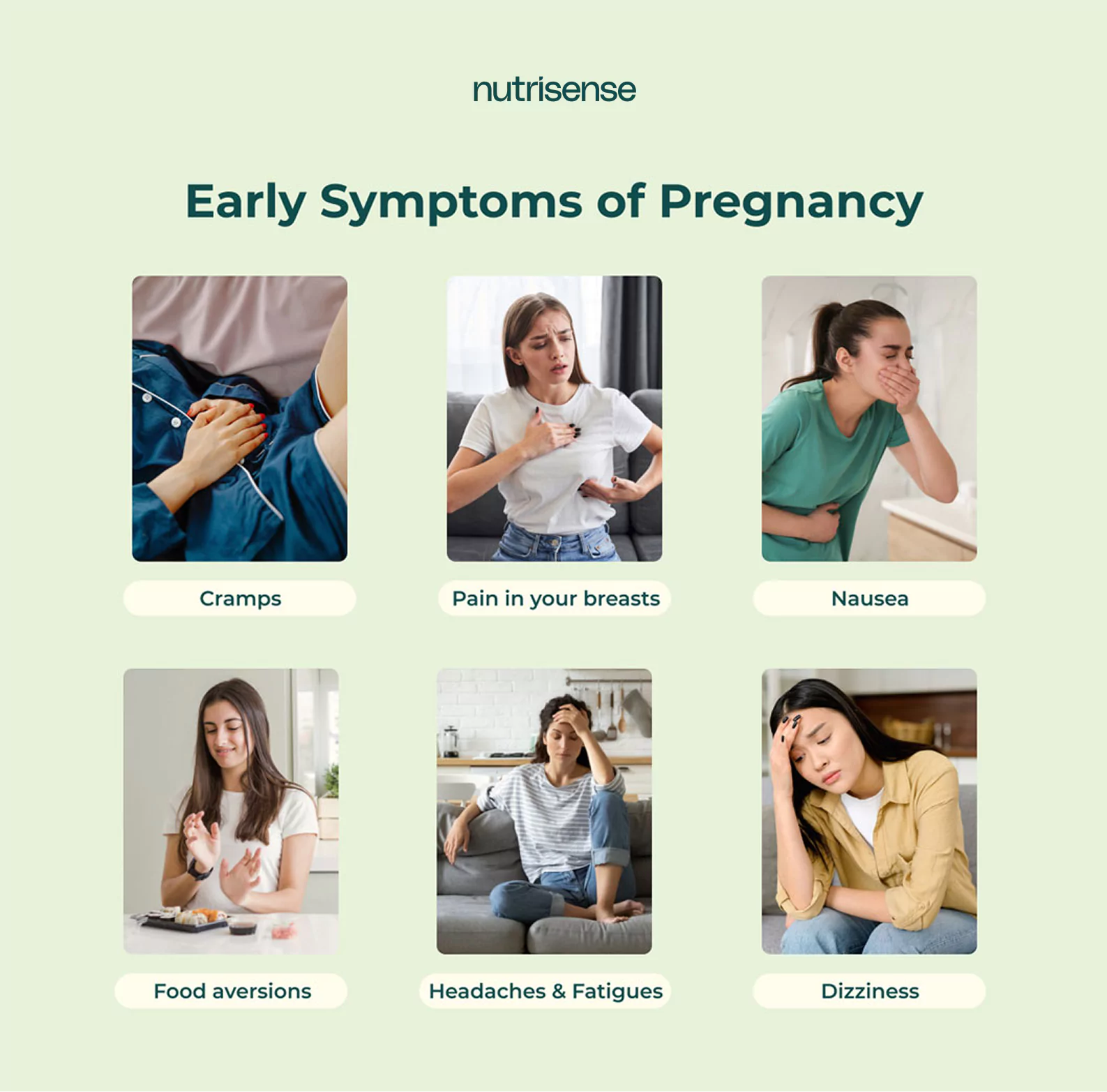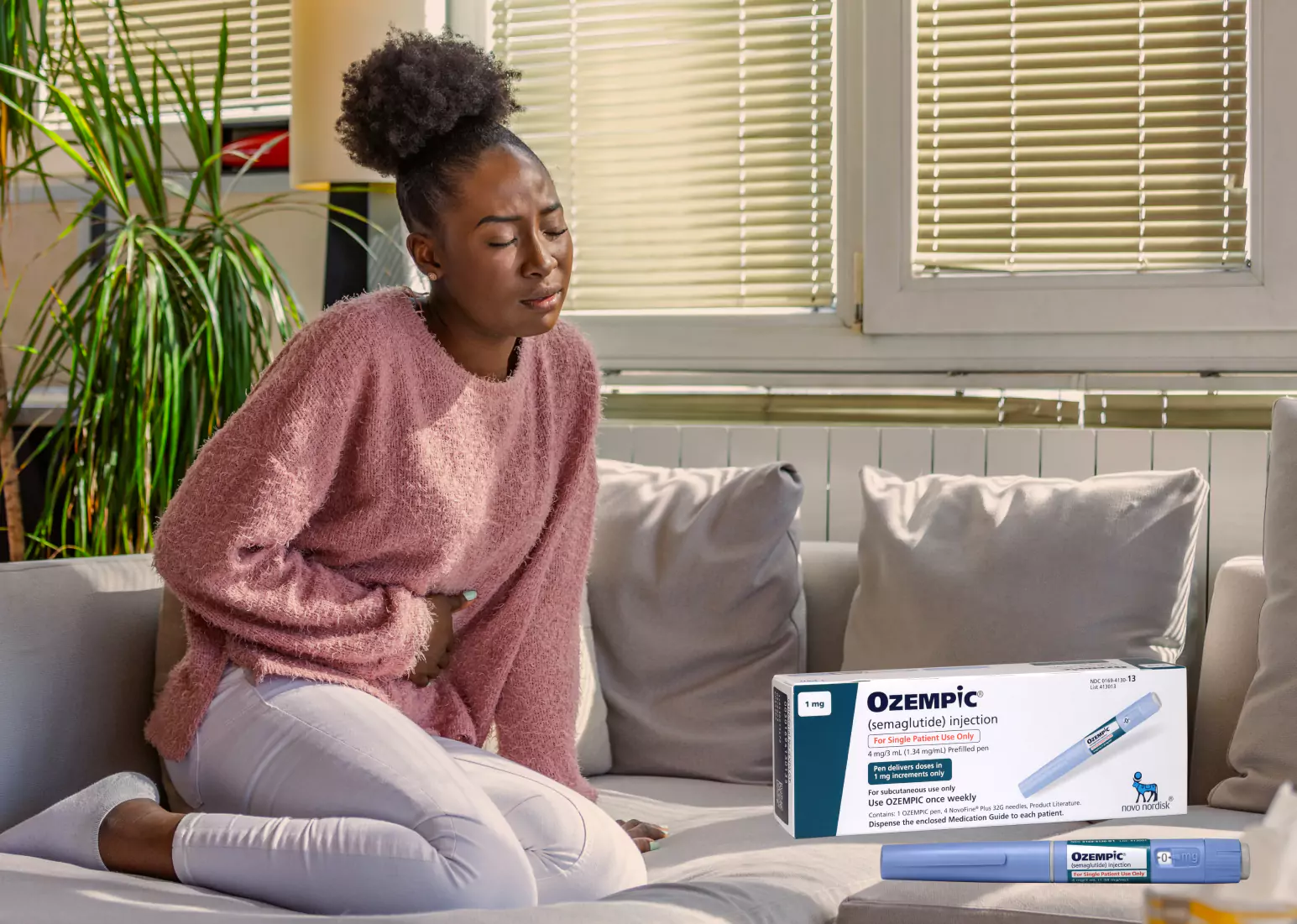Cramps But No Period: What Are the Causes?

Key Takeways
Do you have menstrual cramps, but you're not expecting your period? Have you had extended periods of abdominal cramping, bloating, and swelling that feels exactly like your period but isn't?
Many people experience symptoms akin to menstrual cramping even when they are not on their periods. It's surprisingly common, and various factors can contribute to it, including changes in hormone levels, imbalances in your body's natural chemicals, and fluctuations in your immune system.

What Is Dysmenorrhea?
When you try to research menstrual cramps and discuss the issue with medical professionals, you may come across some terms that you're not familiar with. One of them is dysmenorrhea.
In simpler terms, dysmenorrhea refers to uncomfortable or severe menstrual pain, and it can be categorized into two types: primary and secondary.
Primary dysmenorrhea is the more common type and happens when no underlying medical conditions are causing the painful periods. It usually starts during adolescence and may continue until menopause.
Secondary dysmenorrhea, on the other hand, is caused by an underlying medical condition that affects the reproductive organs. It usually starts later in life and may worsen over time.
Other Common Menstruation-Related Terms You Want To Know
While discussing menstrual cramps, you may come across other terms related to your reproductive health. Here are some of the common ones:
Amenorrhea
Amenorrhea is another important term related to menstrual health. It refers to the absence of menstruation and can also be classified into two types: primary and secondary. Primary amenorrhea occurs when a person has not had their first period by the age of 16. Secondary amenorrhea happens when a person who has previously had regular periods stops menstruating for three months or more.
Premenstrual Syndrome (PMS)
Premenstrual Syndrome (PMS) includes a range of symptoms that occur in the one to two weeks before your period. These symptoms can include mood swings, tender breasts, food cravings, fatigue, irritability, and depression. While mild PMS is common, severe PMS can interfere with daily life and may require medical attention.
Understanding these terms can help you better communicate with your healthcare provider and manage menstrual health more effectively. If you experience severe or unusual cramping, seeking medical advice to rule out any underlying conditions is always a good idea.
Why Do I Have Cramps But No Period?
Dr. Tara Brandner, DNP, FNP-C, explains:
"Experiencing cramps without a period can often be attributed to hormonal shifts within the body. These shifts, particularly involving hormones like prostaglandins, play a pivotal role in triggering cramp-like sensations. Prostaglandins are naturally occurring compounds involved in various bodily processes, including inflammation and smooth muscle contraction. During the menstrual cycle, higher levels of prostaglandins are released in the uterus as part of the body's preparation for shedding the uterine lining. These prostaglandins cause the uterine muscles to contract, leading to the characteristic cramping experienced during menstruation."
These issues can cause inflammation, leading to the pain and discomfort associated with menstrual cramping. Some can be temporary due to switching your birth control. But there are many other reasons, too, from sexually transmitted infections, early pregnancy, and menopause to urinary tract infections like cystitis and more serious conditions like endometriosis or ovarian cancer.
So, while there's no need to panic every time you get a cramp, it is crucial to track and monitor how often and how severe these cramps are so you can address any health issues sooner rather than later.
Here are some of the most common causes to watch out for:
Pregnancy
Pregnancy is one of the most common reasons you may experience cramping during your menstrual cycle (even before you skip your period). Cramping is a typical symptom of early pregnancy, as this is when an embryo begins to implant itself into the uterine lining to grow and develop.

What Kind of Cramps Indicate Pregnancy?
When the embryo implants itself into your uterine lining, you may experience cramping and some other uncomfortable symptoms. In some cases, cramps that come on as an early sign of pregnancy will be mild, similar to PMS symptoms.
However, in some cases, these cramps may cause abdominal pain, discomfort, or even nausea, so it is important to be aware of the potential for early pregnancy.
While not all women will experience pre-period cramps throughout their pregnancy journey, it is worth being aware of this possibility so that you can take steps to treat your symptoms if needed. Occasionally, cramps like this can be warning signs of ectopic pregnancies.
How Late Can a Period Be Without Being Pregnant?
Your period should start within 24 to 38 days of your last one, depending on your cycle. Typically, a period is deemed late if it is at least five days past its expected date. It is considered missed if more than six weeks have passed without a period.
However, menstrual periods often aren't regular during the first few years for young individuals when their menstruation begins. It can take several years for their hormones to reach a balance and maintain a predictable cycle. Irregular periods are also standard as you approach perimenopause and menopause.
If you're sexually active (even if you're on birth control or use other oral contraceptives), get an over-the-counter pregnancy test and seek medical attention if necessary.
Endometriosis
As you may have read in our article about endometriosis, it occurs when the uterine lining (the endometrium) begins growing outside the uterus. It can happen in various places throughout the body, such as in the fallopian tubes, ovaries, or bladder. In some cases, endometriosis can also spread to the digestive system or lungs.
Endometriosis usually develops during a woman's childbearing years and may affect approximately 11 percent of American women between 15 and 44. worldwide. Although the exact cause of endometriosis is unknown, there are several theories about how it may develop.
The oldest theory suggests that endometriosis may be due to retrograde menstruation, when menstrual blood flows backward through the Fallopian tubes and into the pelvis. Another theory suggests that an immune system disorder may cause endometriosis. Regardless of its cause, endometriosis can cause various symptoms, including pelvic pain, cramps, and infertility.
"Conditions like endometriosis and polycystic ovary syndrome (PCOS) can lead to chronic hormonal imbalances. In these cases, abnormal levels of hormones such as estrogen and progesterone can result in heightened prostaglandin production, even in the absence of a regular menstrual cycle. This excess of prostaglandins can lead to more frequent and intense cramping sensations."
Endometriosis diagnosis involves a combination of medical history, physical examination, and imaging tests. Dr. Tara Brandner DNP, FNP-C shares, adding, "in my practice, I see this in undiagnosed endometriosis almost always. I see providers overlooking this disease and dismissing it. So many women have it and don't even know it."
Treatments for endometriosis may include medication, surgery, or a combination of both. If you think you may have endometriosis, book an appointment with your gynecologist to discuss your symptoms.
Ovulation

Ovulation is when an ovum, or egg, is released from a woman's ovaries into her fallopian tubes. It typically occurs once per month, during your fertile window—the limited period of each menstrual cycle in which conception can occur.
While ovulation is necessary for reproduction and conception, it can also cause several uncomfortable side effects, including cramps and discomfort in the lower abdominal area.
These cramps may be due to a sudden release of prostaglandins, hormone-like chemicals that trigger uterine contractions and inflammation. While not everyone experiences these ovulation-related cramps outside their period, they are the simplest and most common reason for such discomfort.
Commonly called "ovulation cramps," the mild contractions can cause a dull ache on one side of the lower abdomen or lower back. While these cramps occur naturally and often go unnoticed, they can also be a sign of hormonal imbalance or other underlying health conditions.
So if you notice any unusual discomfort in your lower abdomen during ovulation, it's best to consult with your doctor to ensure that you stay healthy and avoid complications.
Miscarriage
A miscarriage, which is the loss of a pregnancy before it comes to term (the NIH describes it as loss of pregnancy less than 20 weeks gestation), is another reason for menstrual cycle-like cramps.
If you're pregnant, one of the most common signs of a miscarriage is cramping, which feels like menstrual cramps. It can be one of the early signs caused by the uterus contracting to expel the tissue growing inside it. The cramps may be accompanied by light bleeding or spotting, which can often be mistaken for a normal period.
Some spotting during pregnancy is usually no cause for alarm. But if you're bleeding, and it's heavier than a normal period and accompanied by severe cramps, it's essential to seek medical attention, as this may be a sign of an incomplete miscarriage.
Incomplete miscarriages occur when not all of the pregnancy tissue has been expelled from the uterus and can often lead to infection. As a rule, if you experience any abnormal bleeding or cramping during pregnancy, it's crucial to speak to your doctor as soon as possible.
Pelvic Inflammatory Disease (PID)

Pelvic inflammatory disease (PID) is an infection of the reproductive organs that can cause severe pain and cramping. The most common symptom of PID is pelvic pain, which can feel like menstrual cramps.
Other symptoms may include fever, chills, vaginal discharge, pain during sex, and burning urination. If left untreated, PID can lead to infertility and ectopic pregnancy.
PID is usually caused by bacteria transmitted during sexual intercourse. Anyone sexually active is at risk for PID, but those with multiple sexual partners or who douche regularly are at increased risk.
Treatment for PID typically involves antibiotics. In severe cases, hospitalization may be necessary. Prompt treatment is essential to preventing long-term complications from PID.
Ovarian Cancer
Many people experience cramps at some point in their lives, and most of the time, these cramps are nothing to worry about. However, they can be a sign of a more serious condition or complication in some cases, including infections in your cervix, ovarian cysts, or ovarian cancer. Cancer of the ovaries is a relatively rare form of cancer but is challenging to detect in its early stages.
One of the first signs of ovarian cancer is persistent or severe pelvic pain. This pain may feel like cramps, which can occur even when you are not menstruating. Other symptoms include bloating, difficulty eating, and sudden and unexplained weight loss.
If you experience any of these symptoms, it's essential to see a doctor for a diagnosis. Early detection is crucial for the successful treatment of ovarian cancer.
Irritable Bowel Syndrome (IBS)
Do you find yourself running to the bathroom when you eat certain foods or are experiencing a lot of stress? You may have irritable bowel syndrome if this is accompanied by bloating and severe cramping.
Irritable bowel syndrome, or IBS, is a relatively common functional disorder that affects the large intestine. Its symptoms include:
- Abdominal pain and cramping
- Irregular bowel movements
- Constipation
- Bloating
For many, IBS cramps can feel very much like the cramps you feel during a menstrual cycle or make menstrual cramps feel worse. People with IBS describe feeling sharp pains in their abdominal region just before or during their period.
Some researchers believe it may be due to changes in hormone levels that occur naturally during menstruation. But regardless of its underlying cause, numerous effective treatments can help you manage IBS-related cramps. For those dealing with this symptom of IBS, making lifestyle changes such as maintaining a healthy, IBS-friendly diet, working with a registered dietitian, and having a good exercise regime may help alleviate discomfort.
Sometimes, severe abdominal cramping can also be a symptom of IBD or inflammatory bowel disease. IBD, which includes conditions like ulcerative colitis and Crohn's disease, is similar to IBS but with more serious symptoms, including bleeding and inflammation in the GI tract. It's a good idea to rule it out with a healthcare professional, even if you have mild symptoms.
Urinary Tract Infections (UTIs)
Urinary tract infections happen more often in women than men. They are caused by bacteria infecting the urinary tract, resulting in symptoms such as a constant urge to urinate, a burning sensation during urination, and lower abdominal cramps.
For women who use tampons, UTIs can sometimes occur due to the use of tampons that are not changed frequently enough. Bacteria from menstrual blood can enter the urinary tract through the urethra, lead to an infection, and cause what's commonly known as the "toxic shock syndrome" (TSS).
To avoid UTIs during menstruation, it's important to change tampons frequently and practice good hygiene, especially during hot, humid weather, when bacteria can multiply quicker.
If you experience any of these symptoms or suspect a UTI, see your doctor for proper diagnosis and treatment with antibiotics. Untreated UTIs can lead to severe kidney infections and other complications if left untreated.
Appendicitis
Another possible cause of your cramping can be appendicitis. To understand this, let's focus on the appendix for a minute.
The appendix is a small pouch of tissue attached to the large intestine, which is responsible for absorbing water and electrolytes from indigestible food products.
Your body eliminates these indigestible food products via fecal waste. The appendix is thought to assist in this process by storing good bacteria.
However, when the appendix becomes irritated and inflamed, it can rupture and cause problems and health conditions like appendicitis. Symptoms of appendicitis include abdominal cramping, nausea, and vomiting. If you're experiencing these symptoms for a prolonged period, seek medical attention since a ruptured appendix can be serious.
Treatment for appendicitis typically involves surgery to remove the inflamed appendix. In most cases, the surgery is successful, and the patient makes a full recovery. However, complications can occur in some cases, so discussing the risks with your surgeon before opting for the procedure is important.
Hormonal Imbalance
When hormone imbalance occurs, it can cause a variety of symptoms, including stomach cramps and other discomforts. Hormones play a crucial role in regulating various bodily functions, including the reproductive system. When there's an imbalance, it can trigger a range of symptoms, including irregular menstrual cycles, severe menstrual cramps, and pelvic pain.
A common cause of hormonal imbalance in women is Polycystic Ovary Syndrome (PCOS), which affects the ovaries' ability to function properly. Symptoms of PCOS can include severe cramping, irregular periods, weight gain, and acne. Hormonal imbalances are not limited to the reproductive system; they can also affect mood and energy levels, leading to fatigue, depression, or anxiety.
Another condition often associated with hormonal imbalance is endometriosis, where tissue similar to the lining inside the uterus begins to grow outside the uterus. This can result in severe cramps, chronic pain, and infertility.
Treatment for hormonal imbalances typically involves lifestyle changes such as diet and exercise, along with medication to address specific symptoms. Hormone replacement therapy (HRT) and hormonal birth control pills are commonly prescribed to help regulate menstrual cycles and alleviate cramping. Always consult with a health care provider to diagnose and treat the underlying cause of hormonal imbalance effectively.
Drastic Body Weight Changes
Experiencing rapid weight gain or loss can affect your overall health and well-being. Sudden fluctuations in weight and body fat may lead to various health issues, including cramps and discomfort. Rapid weight gain often puts additional pressure on the digestive system, causing bloating and abdominal cramps. Conversely, drastic weight loss can result in muscle breakdown and electrolyte imbalances, which can also lead to cramping.
If you experience significant weight changes, seeking advice from a healthcare provider is essential. They can help identify underlying causes and offer guidance on managing your weight effectively while minimizing the risk of cramps and other related symptoms. Proper medical consultation ensures you address potential health issues early, paving the way for a healthier and more balanced lifestyle.
Stress and Anxiety
Stress and anxiety are part of our daily lives, and we all experience them to varying degrees. However, excessive stress and anxiety levels can lead to chronic health conditions due to the body's physiological response to stress hormones like adrenaline and cortisol.
These hormones trigger a "fight or flight" response that prepares the body for perceived danger, causing various physical symptoms such as muscle tension and cramping. This response can also affect digestion, leading to stomach discomfort and cramps.
Practicing stress management techniques such as exercise, deep breathing, and mindfulness can help alleviate stress and anxiety levels. Seeking the support of a mental health professional may also be beneficial in managing chronic stress and anxiety.
Excessive Exercise
Many women professional athletes experience amenorrhea, where they stop menstruating due to the extreme physical demands of their sport. Intense exertion can cause hormone imbalances, especially in estrogen, which regulates the menstrual cycle. This can lead to irregular or absent periods, causing discomfort and pain during ovulation or menstruation.
Birth control pills are occasionally used to regulate menstrual cycles in athletes. However, collaborating closely with your doctor and nutritionist is vital to determine the most suitable solution for your needs.
Ensuring adequate rest, hydration, and nutrition is crucial for maintaining a healthy balance between physical activity and hormonal health. Listen to your body and take breaks when necessary, as overexertion can lead to long-term health consequences.
Thyroid Hormone Imbalance
Thyroid hormones regulate metabolism, energy levels, and overall physiological balance. An imbalance can lead to various symptoms, such as cramps, fatigue, weight fluctuations, and mood swings.
Hyperthyroidism occurs due to overactive thyroid glands, accelerating metabolism and leading to unintentional weight loss, rapid heartbeat, muscle cramps, and sometimes hot flashes. In contrast, hypothyroidism is characterized by insufficient hormone production, which slows metabolism, causing weight gain, fatigue, muscle pain, and even vaginal dryness.
Women are particularly prone to thyroid disorders, such as hypothyroidism or hyperthyroidism, due to hormonal fluctuations during various stages of their life, such as pregnancy, menopause, or postpartum. Managing thyroid hormone levels through medication and regular check-ups with a healthcare provider can help alleviate cramps and other symptoms associated with an imbalance.
Find the right Nutrisense programto turn insight into progress.
How To Diagnose What Your Cramps Mean
Whether you have severe or mild cramps, ignoring them just because you don't have your period is a bad idea. But it can be challenging to diagnose cramps with no period. Is it just a tummy ache? Is it painful bladder syndrome?
To find possible causes, start by tracking your menstrual cycle—and pay particular attention to any missed periods. Look for other symptoms when you get a cramp, like pain or discomfort in the pelvic area or legs, onset of back pain or headaches at about the same time as the missed period, or other symptoms of cramp-like pain.
When you track your menstrual cycle, you can stay aware of any other unusual symptoms that occur at around the same time each month. And remember, if your cramping is accompanied by nausea or bleeding that is not associated with your normal period pain, it's important to see your doctor immediately.
To properly diagnose your cramps, track any other symptoms or health issues. Additionally, share any relevant medical history and family history with your doctor for a more accurate diagnosis. If necessary, testing such as ultrasounds or blood work may also be conducted.
FAQs About Cramps and Periods
.jpg)
The women’s health experts at Nutrisense address some common questions about cramps, periods, hormonal changes, and more! There’s a lot to consider when you experience this, so working with an expert is your best bet to figuring out the questions below and learning more about your body. As expert Amanda Donahue, MS, RD, CD, explains:
“I commonly look at my female member's age, menstrual cycle details (is she peri/post menopause), daily caloric intake, physical activity amounts/intensity, and overall stress/sleep quality to assess how to support proper hormone function in the body.”
What causes a ghost period?
A ghost period, sometimes referred to as a phantom period, refers to the experience of menstrual-like symptoms, such as cramping, bloating, and mood swings, even though menstruation doesn't occur. There are many reasons why you might experience a ghost period, including hormonal imbalances, stress, and lifestyle factors. It's essential to track your symptoms and speak with a healthcare provider if you're experiencing frequent ghost periods.
Are false periods a thing?
False periods can happen if you take contraceptive pills that suppress ovulation. These "withdrawal bleedings" mimic a menstrual cycle but are not true periods. It's important to understand and track your menstrual cycle, even if you're on birth control, to distinguish between false periods and actual periods.
Can exercise affect my menstrual cycle?
Yes, excessive exercise (amounts and intensity depend on your unique body) can lead to changes in hormone levels and disrupt the regularity of your menstrual cycle. This can result in irregular or absent periods, causing discomfort and pain during ovulation or menstruation. Finding a balance between physical activity and rest is essential for optimal hormonal health.
What are the signs that your period is not coming?
Common signs that your period may not be coming include recent missed periods, prolonged menstrual cycles, and significant irregularities in your cycle. Additional indicators can include symptoms such as persistent fatigue, hormonal acne, sudden changes in weight, and hair loss. If you experience any of these symptoms, speak with a medical professional for an accurate diagnosis and treatment plan.
Manage Your Hormones and Your Health with a Nutrisense Expert
Your hormones play a significant role in regulating your menstrual cycle, but they also affect your blood glucose levels and overall health. Hormone imbalances can also lead to fluctuations in blood sugar, causing cramping, fatigue, and mood swings.
If you want to learn about what you’re experiencing and how to manage hormonal imbalances, consider working with an expert like a registered dietitian with expertise in hormonal balance, glucose, and women’s health. At Nutrisense, you can work 1:1 with a credentialed nutritionist and dietitian via insurance-covered video calls on dietary and lifestyle changes that can help you determine the root cause of your cramps. By monitoring your body's response to various stimuli, a skilled expert can provide personalized recommendations for improved hormonal health.
Comprehensive health programs, like the Nutrisense CGM program, also give you access to health tech, such as continuous glucose monitors (CGMs) and glucose biosensors. You can get expert advice and look deeper into your body’s data for valuable insights into your daily response to different foods, exercise, and stressors.
Go Beyond Glucose Data with Nutrisense
Your glucose can significantly impact how your body feels and functions. That’s why stable levels are an important factor in supporting overall wellbeing. But viewing glucose isn't enough. Nutrisense, you’ll be able to learn how to use your body's data to make informed lifestyle choices that support healthy living.
One-to-one coaching
Sign up to access insurance-covered video calls to work with a glucose expert: a personal registered dietitian or certified nutritionist who will help tailor your lifestyle and diet to your goals.
Monitor and measure what matters
With the Nutrisense CGM Program, you can monitor your glucose with health tech like glucose biosensors and continuous glucose monitor (CGM)s, and analyze the trends over time with the Nutrisense App. This will help you make the most informed choices about the foods you consume and their impact on your health.
Find your best fit
Ready to take the first step? Start with our quiz to find the right Nutrisense program to help you take control.

Natalie received her degree in Dietetics from Mansfield University and a Master’s in Clinical Nutrition from the University at Buffalo. Her career has included nutrition education and program development in her local community, adjunct faculty at several collegiate institutions, and clinical nutrition in both inpatient and outpatient settings.




